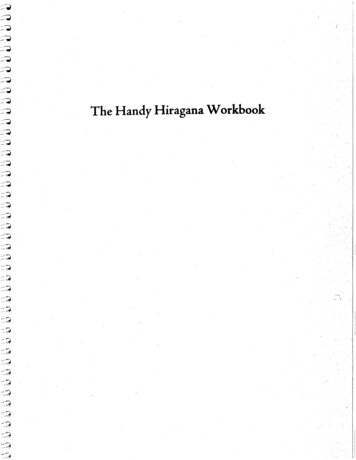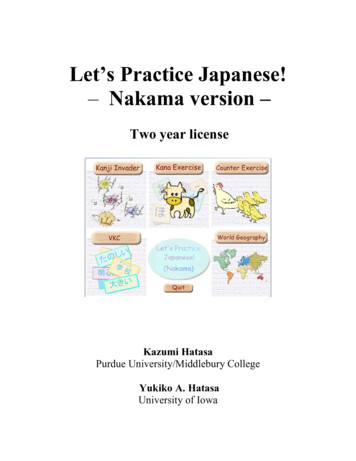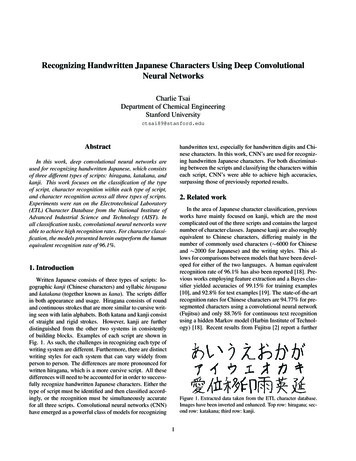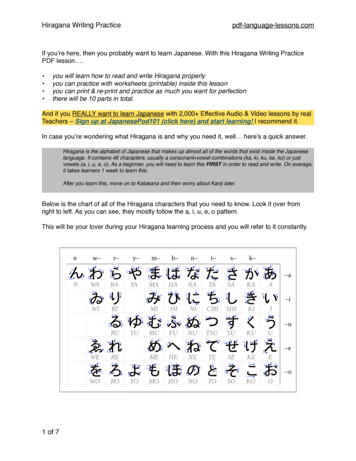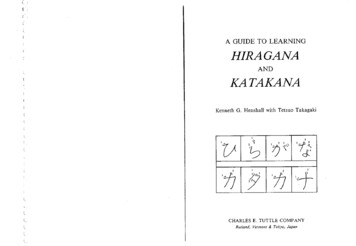
Transcription
The Secrets to Quickly Mastering Japanese /日本語最速マスターの秘訣How to Learn JapaneseInfants’ Learning Method using Memory MagicFREE!Created by
You Will See How Easilya n d Q u i c k l y Yo u C a nMaster Japanese!日 本 語 がいかに簡 単 にマスターできるかに ほん ごOther Examples /他の例ほかTRANSPORTATれいMemorize first two Japanese characters.Then, you can remember the words easily. station 〇park かん たんkouenn / 公園See p27 for theこうえんpa-ku / パークおわかりいただけます。First, you need to understand a bit about thebackground of the Japanese language. You willthen discover how easily you can learn Japanesewith our revolutionary new learning technique,ek27 ページのA koala (ko) is riding on the back of a wolf(u) in the park.公園 (こう) で koala (こ) が wolf (う)railway teこうえんの背中に乗っている。せ なかFrom theline, a tsuru (tsのwhich emphasizes the importance of �� tsuru (つこの小 冊 子でまず初めに日 本 語の仕組みとしょう さっ しはじに ほん ごし く革 命 的 な学 習 法 を理 解 してください。従 来かく めい てきがく しゅう ほうり かいじゅう らいの学 習 法 とは全 く異 なり、単 語 の学 習 を第がく しゅう ほうまった ことたん ごがく しゅう �記術て簡 単いちたん ごま ほうlaundry あん まクリーニング店subway〇a torcHoldingつかてんhis hair cut at thA chimpantorch(と)wereshakingsubway stationに覚えられます。Instead of tenn, ya is often used casually, asin kuri-ninnguya.For example: How to Memorize “eki” (station).「店 」 の代 わりに、 クリーニング屋 のよう anzeeにカジュアルでは 「屋」 �口おぼか てつeki is composed of the characters “e” and “ki.”The pronunciation is represented by “e” for anelephant and “k” for a king (using the first syllableof each word). Imagine an elephant having afierce battle with a king at a station. (See the frontcover.)例:駅の覚え方れい えきおぼかたえきも じくあおとえい ごし や くびしょよういんthe ofcitya sheep(shi)“byouinn”knockedThe Atsoundthishallwordresemblesdown a yakuza (ya).(hospital).ぞうおうさま美容院 (びよ) の中で大きな bee (び)なかおおおとあらわえきく �イメージしてください ( 表あらそひょう紙 参 照 ��りし �まえStores thatoffこにたくさんのresutorann,butthat serve inexpが yoga (よ) をしている女性を襲っている。い 役おそward office ku'yakushoじ/ょ せ区所最 �激さいしょMEALSbusstop AND〇市院役」所と似で sheep(し)「病た発音。 が yakuza ( や ) を restaurant し いやんく し ょびょうにはつおんMany batspitchedin fronした。殴り倒the beauty parlor a big bee (bi) isな ぐ Inたおattacking a woman who is practicing yogaバス停 の前び ��king(王様)のぐちcity hallsalonshi'yakusho/ 市/役美所容院beauty〇 biyouinn(yo).「駅」(eki) �� 的な店は食しゅう て きみせしょ Used in Japanese〇 Most Japanese know Some Japanese know Used in Japanese, but deviates from the original English wordUsed as a hint in*No marks mean the word is not much used.*The most frequently used word is placed on the top of each word.cafe / tearoomAfter acquiring the Japanese printed inthis booklet, you may proceed to the nextstep. Here, the text, Super-effective JapaneseA king (ki) bSanta Claus (saLessons “Basic Japanese” is recommended:See page 19.tsuru (っ) を S喫茶店で kiきっ さ てん飛ばしていますとbarber tokoya / 床屋とこ やriyoushitsu / 理容室り ようしつvending machine
This Timeʼs Theme �語レッスン!に ほん ごThe Secrets to Quickly MasteringJapanese From ScratchTimeless ��秘訣ほ ぞんばんさHiragana Times has developed a method ofmastering Japanese that will enable you tospeak the language in a surprisingly shortperiod of time. It is completely differentfrom conventional methods and has beenregistered as a utility model with the JapanPatent ��間で日おどろたん き かんに本語がマスターできる学 習 法を開発しまほん ごがく しゅう ほうスーパー日本語講師のレッ ス ンSuper-effectiveJapanese Lessonsかい はついそくひけつBefore beginning actual lessons, in this issuewe will explain how you can master Japanesein a short �うほうたん き かんかい説します。せつした。 従 来 の学 習 法 とは全 く異 なるものじゅう らいがく しゅう ほうまった ことで、 日本の特許庁で実用新案に登録さに ほんとっ きょ ちょうじつ よう しん あんとう ろくれました。Features /特 徴1. Applying the process infants use tomemorize the vocabulary they need intheir daily lives.JapaNEEDS&JAPANeseと く ちょう幼児が日 常 生活で必要な単語からよう じに ち じょう せ い か つひつようたん ご覚える過程を応用。おぼか てい2. Taking advantage of readers’ knowledgeof internationally used 知識をし ようえい ごち しき最大限に利用。さいだいげんり よう3. Applying the principles used to remember abnormal ��理い じょうでき ごとわすき おくげん りを応用。おう よう4. Using alphabetic script that can be converted into correct Japanese ��アルもじに ほん �。もじし ようもく じThe Structure of Japanese Phonics ��みに ほん ごおうようこくさい ごContents /目次おんせいも じし く1. You Can Convey Your Intentions UsingOnly Simple ん ごい しつた2. Many English Words Are Used ��て使われているえいたん ごに ほん ごつか10-113. English Loan Words Are Pronouncedwith Japanese ��るえいたん ごに ほん ごおんせいはつおん12-14Magical List to Aid Pronunciation �ックリストはつおんあん きほ じょ15-183
��講師The Structure ofJapanese Phonics andCharacters日本語の音声と文字のに ほん ごおん せいも じ仕組み[し くThe Basic 45 Phonetic Sounds AreEasy to Acquire基本の 45 �いかんたんおぼ]In Japanese there are 45 basic phoneticsounds as well as additional derivative phonics. They consist of the five vowels sounds(a, i, u, e, o) combined with nine consonants(k, s, t, n, h, m, y, r, w). Vowels are also usedon their own. The special consonant “nn” isused differently.日 本 語 には 45 の基 本 音 声 とそれらのに ほん ごき ほん おん せいいつぼ いんし いんくみ合 わされています。 母 音 は単 独 でも使 用あぼ いんたん どくし ようされます。 特 別 な子 音 nn は、 通 常 の使とく べつし いんい方と異なります。かたことBasic phonics /基本音声き ほんおんせい4えいつ う じょうつかご]かんたんThe sounds produced by letters in the Englishalphabet differ depending on the word itself.For instance, “ta” changes according to theword: “take” is pronounced as teik, “talk”as to-k. In Japanese, the pronunciation of acharacter never changes regardless of theword. The English word “take” would be pronounced as “ta ke” (bamboo). There is onlyone set way of pronouncing phonetic furigana (hiragana and katakana) Japanese ��語ごとえい ごはつ おんたん ごに変 わります。 たとえば、 take はテイクと、かtalk ではトーク、 つまり、 ta の音は、 単語おとたん ごにより発 音 が異 なります。 日 本 語 では文ことに ほん �ません。じと 9 つの子音 (k, s, t, n, h, m, y, r, w) が組ここのはつおんはつ おん派生音があります。5 つの母音(a, i, u, e, o)は せいおん[Japanese is Easier to Pronouncethan �� おんたん ごか英語の take ( 取る ) は、 ta と ke の組み合えい ごとくあわせた 「たけ」 ( 竹 )、 と発 音 されます。たけはつ おん日 本 語 音 声 が 1 つしかなく文 字 と一 致 しに ほん ご おん せいひともじいっ ちます。There are three different set of characters: alphabet (romaji ), hiragana and katakana .
んせいスー パ ー 日 本 語 講 師 の 技 能EnglishLetters of the Alphabet and Phonicsthat Are Not Used in ット]With E n g lish so u n d s th a t d iffe r f r omJapanese sounds, the sound that most resembles the sound in Japanese is used, “r” insteadof “l” and “b” instead of 、 日に ほん ごおん せいえい � 「l」は「r」を、ほん ごにおとつか「v」 は 「b」 を使います。 「l」 「v」 �。take (タケ)つかExample/例:milk miruku (ミルク)れいvisa biza (ビザ)Notes for Basic Phonetic Sounds基本音声の注意点き ほんおんせいちゅう い て んThe syllables in parenthesis are the mostcommonly used way to write that sound inthe Roman alphabet.カッコ ( ) 内に表記された文字 (英語ないひょう �を活用して教えられるJapanese*The letters of the alphabet, c, q, and x, arereplaced as below:c, q, x �おかc k, q k, x zえい ごの表記に基づく) が一般的に使われていひょう きもといっ ぱん てきつかます。*The syllables in square brackets are mainlyused for English words.角カッコ [ ] �せいおもえい � in is pronounced the same as “o” butthis spelling is only used on special occasions.山カッコ 内の wo ( を ) は o (お) とやまない同 じ発 音 で、 この綴 りは特 別 な場 合 に使おなはつ おんつづとく べつば あいつかわれます。*“nn” is not used alone. It is used as a suffixfor a syllable.nn は単独では使われません。 1 � rities of Japanese Script ��ほんごどくとくひょう きはつおん]Long Vowel /長音ちょう お んExample/例:coffee ko-hiれいstreet sutori-toDouble consonant /促音 ( 詰まる音 )そくおんつおんExample/例: hat hatto (ハット)れいset setto (セット)つ5
[There are Four Different Kinds ofJapanese Script日本語の文字は 4 種類あるにほんごもじしゅるい]It is thought that written Japanese is very difficult to learn, since four different scripts areused. However, if you alter your perspectiveon this issue, you will find it much easier.Hiragana and katakana were created to represent particular sounds. Romaji is the waythese sounds are represented in the Romanalphabet. Those familiar with the alphabetcan learn Japanese phonics with romaji. Kanjican be acquired later.日 本 語 の文 字 には4種 類 の文 字 が使に ほん ごもじしゅ �す。 しかし、 見ようふく ざつみ方 を変 えればとても簡 単 です。 ひらがな、かたかかん �� ローマ字 はそれらをアルファベットで1) Hiragana : Phonetic script.表 �ザーひらがな : 表音文字じひょう �ます。じに ほん �。かん じあとが く しゅうひょう お ん もじ2) Katakana : Phonetic script mainlyused for loan words from English orother Western languages. It is often usedfor animals and plants.カタカナ : 表 音 文 字 (主 に外 来ひょう お ん もじおもがい らい語 に使 用 します。 動 物 や植 物 に使Romaji is mainly used in signage for thenames of railroad stations and public facilities. However, there are a few different romaji script styles with slightly different spelling.Some of these do not match with Japanesephonics.ローマ字は主に駅名や公 共 施設名のじおもえきめいこ う きょう し せ つ め い標 識 に使 用 されています。 しかし、 ローひょう し いものなかがあります。6おん せいいっ ちしょく ぶ つつか3) Romaji : Alphabetic phonetic script.ローマ字 : アルファベット表音文字じひょう お ん もじ4) Kanji : Ideographic script importedfrom China (2,136 kanji are commonlyused in Japanese).漢 字 : 表 意 文 字 (中 国 から取 �り、 駅ことどう ぶつわれることもあります)し ようじし ようかん じひょう いもじちゅう ご くと入 れた文 字 で、 日 常 で使 う常 用 漢いもじ字は 2,136)じに ち じょうつ か じょう よ う か ん
[You Can Cut Down on Time SpentStudying Script by Using GlomajiGlomaji の使用で省ける文字学 習しようはぶもじが く しゅう]In this text, Glomaji (global romaji ) textis used. It’s a romaji system that has beendevised so that phonics match with characters. Hiragana Times has advocated Glomajiand used it in the magazine. It is so easy,since it is written in the same way as it is pronounced, so you won’t have to learn it fromscratch. Since you can practice it at home,you won’t need to study it here. However, sothat you can become familiar with it, standard Japanese script is printed together withGlomaji.Peculiarities of GlomajiGlomaji の特 徴と く ちょう1. This is the script that is used for converting alphabetic keyboard input intoJapanese script; most Japanese use thismethod when typing with a PC.日本語に変換する前のアルファに ほん ごへん かんまえベット文 字 で、 日 本 人 のほとんどがこもじに ほん �す。ほうしきにゅうりょく2. You can convert it into the correcthiragana , katakana and kanji .ひらがな、 カタカナ、 漢 字 に正 しくかん ��Nんンなナ女3. Since the spelling is based on Englishphonetics, you can input text withoutbecoming confused.アルファベットのスペルは基 本 的 にき ほん てきこのテキストでは、 ローマ字 を音 声 と文じおん せいも字 が完 全 に一 致 するスペルに改 良 したじかん ぜんいっ ちか い りょうGlomaji (Global romaji) を使用します。 これし ようは Hiragana Times が提唱し、 実践してきたて い しょうじっせん方 式 です。 発 音 通 りに入 力 するだけですほう しきはつ おん どおにゅう りょくのでとても簡単で、 新たに学ぶ必要はあり英 語 の音 をベースにしていますので、えい �ゅうりょく4. By using a PC, you can learn hiragana ,katakana , and kanji all by yourself.ひらがな、 カタカナ、 漢字の学 習かん じが く しゅうは、 パソコンで自習できます。じ しゅうません。 文字の学習は自習できますので、5. You can communicate with Japanesepeople in Glomaji �せん。しかし、日 本 語 に変 換 せずに Glomaji �じんでもらで日 本 人 �、 Glomaji �もじあらまなが く しゅうひつようじ しゅうじに ほん ごもじに ほん ごへん かんに ほん じんへい き7
The Secrets to Quickly Mastering *********************************1. You Can ConveyYour Intentions UsingOnly Simple WordsJu-su単語だけでたん ご意志は伝えられるい ************Orenji ju-suAlmost all Japanese language texts start byteaching sentence structures and grammar.As it is boring memorizing so many rules,you may find this discouraging. In fact, if youknow some simple words you can conveyyour 、 構文及びに ほん � �かずMotto orenjiju-suに �、 やる気ごき そくおぼきを失ってしまいます。 現実には、 単語さえうしなげん じつたん ご知 っていればあなたの意 志 を伝 ts communicate with their parents usinga single word such as, “juice.” After sometime, they can be more specific about the waythey express themselves, adding another wordsuch as “orange,” to make “orange juice.” Inthis way they can build sentences by addingother words, as in “more orange juice.” Inthese lessons we will begin with the memorization of words needed for daily life.幼 児 は 「ジュース」 のように 1 つの単よう じひとたん語 だけを使 って、 親 �っています。 やがて �一つ単語を加え、 より明確に表ひとたん ごくわめいかくひょう現 できるようになります。 そして、 「もっとオげんレンジジュース」 のように他の言葉を加えてほかこと ��では、 日 常 生 活 で必 要 な単に ち じょう せ い か ��ぼはじひつ ようたんEven if you omit some words in your sentences, you can still communicate withJapanese people.文 章 の中 のいくつかの単 語 を省 いてぶ ん しょう な かたん ごはぶも、 � ほん じんます。と
Excuse me.Do you speak Japanese?① Sumimasen.excuse meすみません。Anata hayouあなた はEigo wohanashi masu ka.えいご をはなし ます か。Englishdo you speak?In short, the only word you need to communicate is “Eigo.”つまり、 �つよう「英語」 だけです。たん ごえい ご⑤ English?If you don’t remember the word, you don’thave to worry. You can simply say “English?”Almost all Japanese understand the �ても大 丈 夫です。② Anata haEigo woあなた はえいご をhanashi masu ka.はなし ます か。こと ばおもだだ い じょう ぶEnglish というだけでかまいません。 ほとんどの日本人は English と言えばわかります。に ほんじんIn this case you don’t need to remember theJapanese phrase “sumimasenn,” you can simply omit it.いEnglish?「すみません」 を思 い出 せない場 合、 そおもだば �ょうりゃく③ Eigo woえいご をhanashi masu ka.はなし ます か。You might say “Eigo wo Hanashi masu ka,”omitting �ご を はなし ます か」ではぶもかまいません。④ Eigo ?えいご ?Even if you simply say “Eigo?” he/she willunderstand that you want to speak in English.たとえ、 「えいご?」 と言うだけでも、 相手いあい �してくれえい ごはなさっるでしょう。Commonly used English phrasesthat Japanese people can ��フレーズに ほん じんり かいにち じょうえい ごOhayou (gozaimasu).Good morning.おはよう(ございます)。Good afternoon.Konnnichiha.Good evening.Konnbanha.Thank you.Arigatou (gozaimasu).Excuse me.Iʼ m sorry.Sumimasenn.How do you do?Hajimemashite.How are you?Ogenki desu ��めまして。お元気ですか。げん きJapanese people learning English will appreciate it if you useEnglish terms instead. Because you can acquire this vocabulary naturally in Japan, it is not necessary to study them.英 語を学んでいる日 本 �えい ごまなに ほんじんこと ばえい ��んげいし �でしょう。おぼまな9
The Secrets to Quickly Mastering ***が使われるごえ いごいそくひさくExamples /例れいhand ( ハンド ) / te (て)head (ヘッド) / atama ( あたま )In daily life both Japanese wordsand English words are �� んさhair (ヘア) / kami ( かみ ****にごfoot ( フット ) / ashi ( あし )語として使われているごつかに ち じょう せ い か つんTerms related to the body /体に関する用語:からだかんよう ご2. Many English WordsAre Used in Japaneseたくさんの英単語が日本えい たん ごに ほん[ほりょう ほ うつ か]In the past, the adoption of kanji introducedmany Chinese words into the Japanese language. Nowadays many English words havebeen incorporated into the Japanese language.In daily life, both Japanese words and Englishwords are used. This means that Englishspeakers are already familiar with manyJapanese words.neck ( ネック ) / kubi (くび)shoes ( シューズ ) / kutsu ( くつ )waist ( ウエスト ) / koshi (こし)watch ( ウオッチ ) / tokei ( とけい )、Terms related to food /食事に関する用語:しょく じかんよう ごdinner ( デ ィ ナ ー) / yuushoku ( ゆ う し ょ く )rice ( ライス ) / gohann ( ごはん )water ( ウオーター ) / mizu ( みず )かつて、 日 本 人 は漢 字 とともに中 国 語に ほん じんかん じちゅう ご く ごの単 語 を日 本 語 に取 り入 れました。 現 代たん ごに ほん ごといげん だいTerms related to the workplaceではたくさんの英 単 語 を日 本 語 として取 り仕事に関する用語:し ごとかんよう ご入 れています。 日 常 生 活 では日 本 語 とdesk ( デスク ) / tsukue ( つくえ )えい たん ごいに ほん ごに ち じょう せ い か つとに ほん ご英単語の両方が使われています。 そのたえい たん ごりょう ほ うつかめ、 �い ごはなひとおおに ほん ごを知っていることになります。paper ( ペーパー ) / kami ( かみ )document (ドキュメント) / shorui (しょるい)しTerms related to the house /家に関する用語 :In Japan, people start to learn English in elementary school. In addition, many Japanesestudy English in language academies.日 本 では小 学 校 から英 語 を学 び始 めまに ほんしょう が っ こ うえい ごまなはじす。 さらに、 英語学校へ通う日本人はたくえい ご がっこうさんいます。10かよに ほんじんいえかんcar ( カー ) / kuruma ( くるま )floor ( フロア ) / yuka ( ゆか )gate ( ゲート ) / monn ( もん )window ( ウインドー ) / mado ( まど )よう ご
[English words are being used withincreasing �えいごたんごつか]These days, with English being used morefrequently, many original Japanese words aregradually dying out.今 日 では英 語 がより使 われるようになり、こん にちえい ごつか多 くの日 本 語 の単 語 が徐 々 に使 われなくおおに ほん ごたん ごじょ じょつかなっています。Dinner time!Examples /例Oh, yushoku !れいTerms related to the body /体に関する用語:からだかんよう ごearring ( イヤリング ) mimikazari ( みみかざり )necklace ( ネックレス ) kubikazari ( くびかざり )Terms related to food /食事に関する用語 :しょく じかんよう ごmenu ( メニュー ) oshinagaki ( おしながき )computer ( コンピューター ) dennshi’keisannki ( でんしけいさんき )restaurant ( レストラン ) shokudou ( しょくどう)Terms related to the housetable ( テーブル ) shokutaku ( しょくたく )家に関する用語 :いえかんよう ごwine ( ワイン ) budoushu ( ぶどうしゅ )door ( ドア ) tobira ( とびら )Terms related to the workplacekitchen ( キッチン ) daidokoro ( だいどころ )仕事に関する用語:し ごとかんよう ごcalendar ( カレンダー ) koyomi ( こよみ )living room ( リビングルーム ) ima ( いま )11
The Secrets to Quickly Mastering . English Loan WordsAre Pronounced withJapanese Phonics英単語は日本語の音声でえい たん ごに ほん ごおん せいいそくひさくNo! Miruku .Wow! Milk.発音されるはつ おん*************************************The pronunciation of English words that havebeen incorporated into the Japanese languageis a bit different from native English pronunciation. Japanese people might sometimesmisunderstand if you pronounce Englishwords as they are pronounced in English. InJapanese people pronounce these words usingJapanese phonetic sounds.milk ru ネに ほん ごつかえい �ります。 英語で発はつおんすこことえい �ともあります。おんに ほんじんご かい日本人は、 日本語風に発音します。に ほんじんに ほん ご ふうはつおんJapanese phonics either consist of a consonant vowel, or a vowel alone. Japanesepeople do not pronounce consonants aloneas in the “s” in tennis and the “t” in street.Therefore, when English words are used inJapanese, a vowel is added after a consonant.Most of these vowels are “u” and み合に ほん ごおん せいし いんぼ いんくあわせ、 および母 音 単 独 で構 成 されていまぼ いん たん どくこう せいす。 street の t、 tennis の s ように子音単独し いんたんどくの音はありません。 そのため、 日本語としおとに ほん �を加し ようば あいし いんあとぼ �どが、u と o です。はつおんえいたん ごたいおうき ほんおんせい(文字)の変化も じへん か]In Japanese phonics besides the 45 basicphonics and those 22 phonics with an addedy or h, there are other phonics derived fromthe basic phonics. You can easily understandthis by looking at the hiragana and katakanascript below the alphabetic script.日本語の音には基本 45 音とそれらに y /に ほん ごおとき ほんおんExample /例 :h が挿 入 された 22 音 の他 に、 基 本 語 かstreet sutori-to ( ストリート )ら派 生 した音 があります。 ひらがなとカタtennis tenisu ( テニス ��う。れい12[Conjugation of basic phonics(characters) corresponding toEnglish words英単語に対応できる基本音声そ う にゅうは せいみおんほかき ほん ごおとよう いり かい
Derivative phonics with “y” or “h” inserted between the basic が挿入された派生音(文字)き ほんおんせいそ う にゅうは せいおんも22 Sounds / 22 音じおんsye (she)しぇ シェExamples of Usage /使用例:しようれいChina Chaina ( チャイナ )kanews nyu-su ( ニュース )yshoes shu-zu ( シューズ )Exceptions /例外:thiれいがい*The spellings in parenthesis are commonlyused (in English spelling).This belongs to the basic phonic group of tand is mainly used for English words.カッコ内に表記された綴り (英語の表記これはtに属 する音 ですが不 規 則 な音ないひょう きつづえい ごひょう きに基づく) �ぱんてきつかThe scripts under the phonics are hiragana andkatakana.音 声 の下 の文 字 はひらがなとカタカナおん せいです。したもぞくおとふき そくおとで、 �い ごたん ごつかparty pa-thi- ( パーティー )じtea thi- (ティー)13
Derivatives of basic phonics / 基本音声から生まれた派生音き ほんおんせいう29 Sounds / 29 音は せいおんおん*dhi, dhu are irregular alterations and not much used. / dhi, dhu �ん。ふ き そくへん かつかY inserted in the above derivative phonics /「y」が挿入された派生音そ う にゅうは せいおん12 Sounds / 12 音おん14
For PC & MobileClic the headphone for soundMAMA ListHow to Use /使い方 P18つかかた15
MAMA List16How to Use /使い方 P18つかかた
MAMA ListHow to Use /使い方 P18つかかた17
各 日 本 語 の音 にマッチする英 語 名 がExplanation ofMagical List to AidPronunciation �おんあんきほかく に ほん ごば あい4. The English word for the illustration isin the third column. The word in bracketsunder the English is the Japanese translation.Square brackets indicate Japanese words(*shows English spellings) and in this casethe word in brackets indicates the Englishtranslation of the word. If that Japanese wordis used in English, no English translation isgiven.MAMA (Memory Aid MagicalAlternatives)1. In the first column 111 commonly usedJapanese sounds are arranged in alphabeticalorder. In each box is the pronunciation of thatsound in the alphabet, hiragana and katakanascripts. Those just starting with Japanese onlyneed to know the alphabet.1列 目 は一 般 的 に使 われる日 本 語 音に ほん ご おん声 111 じょう だ んベット、 ひらがな、 カタカナの文 字 � 日本語を学び始おとひょう きに ほん ごまなはじめた人 はアルファベットで知 るだけで十 分ひとしじゅう ぶ んです。2. Illustrations (animals, different occupations, products seen in daily life ) are placedin the second column. The first sound used inthese English words matches or is similar toeach Japanese ��の下にれつ めえい ご めいした記された( )の中はその日本語訳です。[ ]しるなかに ほん ご �は英語のスに ほん ごえい ごペルです)。その場 合 の( )の中 はその英ば �に取り入れられご やくに ほん ごえい �ん。ば あいえいやく5. In the fourth column, the Japanese pronunciation of that English word is ��によるれつ めえい ご めいに ほん �6. The characters in under the Japanesepronunciation shows the characters of thealphabet you’d need to input in order toproduce the corresponding Japanese script,besides the standard alphabets in the first column.その下 に記 された の中 ��、上 記 の下 線 �物)が配置されていまダードな入 力 以外に日本語を正しく入 �� めひとどうぶつに ち じょうみえい ご めいものかくおといっ ちじょう きしょくぎょうせんとうおとか せんにゅうりょく い が いはい ちに ほん ごただにゅうりょくに ほん �す。るい じ3. When there is no English word that canmatch the Japanese sound, a Japanese word isused. The inside of these frames is colored ingrey.18し ようわくないじょつかに ほん �ます。せつ めいいっ ぱん てきえい ご めいない場 合 には、日 本 語 が使 用 � めおとThese were prepared to help you memorize Japanese sounds,but they will play an important role later when it comes to acquiring vocabulary, so you should memorize them correctly.ここでは日 本 �しますが、に ほん ごおんせいおぼて ��しっかりのちたん �やくわりは
Super-effective Japanese Lesson asic Japanese (by Magical Memory ��る)Super-effective Japanese Lesson 6/6 People / hito / 人Super-effective Japanese Lesson asic Japanese (by Magical Memory ��る)5/6 Actions / dousa / 動作1/6 Place / basho / 場所2/6 Numerals / suuji / 数字Super-effective Japanese Lesson Text3/6 Days / hinichi / �ト4/6 Appearance / gaikenn / 外見5/6 Actions / dousa / 動作Basic Japanese (Digital version)日本語の基礎(デジタル版)6/6 People / hito / 人Basic Japanese (by Magical Memory ��る)4/6 Appearance / gaikenn / 外見Super-effective Japanese Lesson /6 Place / basho / 場所2/6 Numerals / suuji / 数字3/6 Days / hinichi / 日にち4/6 Appearance / gaikenn / 外見5/6 Actions / dousa / 動作Basic Japanese (by Magical Memory ��る)6/6 People / hito / 人3/6 Days / hinichi / 日にちInfant’s Learning Method UsingMemory 法Super-effective Japanese Lesson /6 Place / basho / 場所2/6 Numerals / suuji / 数字3/6 Days / hinichi / 日にち4/6 Appearance / gaikenn / 外見Basic Japanese (by Magical Memory ��る)5/6 Actions / dousa / 動作6/6 People / hito / 人2/6 Numerals / suuji / 数字1/6 Place / basho / 場所2/6 Numerals / suuji / 数字Super-effective Japanese Lesson Text3/6 Days / hinichi / 日にちYou can learn theme by theme andcommunicate with Japanese ��ト4/6 Appearance / gaikenn / 外見5/6 Actions / dousa / 動作6/6 People / hito / 人Basic Japanese (by Magical Memory ��る)1/6 Place / basho / 場所1/6 Place / basho / 場所2/6 Numerals / suuji / 数字3/6 Days / hinichi / 日にち4/6 Appearance / gaikenn / 外見2,800 yen (six editions)5/6 Actions / dousa / 動作6/6 People / hito / 人Basic Japanese is a series of texts from the Supereffective Japanese Lessons published in issues ofHiragana Times between January to July 2018.1/6 Place / basho / 場所2/6 Numerals / suuji / 数字3/6 Days / hinichi / 日にち4/6 Appearance / gaikenn / 外見5/6 Actions / dousa / 動作6/6 People / hito / 人従 来の学 習 �う らい がく しゅう ほうまった ことに ほん特 許 庁 で実 用 新 � じつようしんあん とうろくLesson Contents:1/6 Unique Method for MemorizingVocabulary (Places & Products)2/6 How to Memorize Intangible Words(Numerals & Money)3/6 How to Memorize Intangible Words(Times & Dates)4/6 Terms that Qualify Target Words(Appearance & Locations)5/6 Terms that Qualify Target Words(Actions & Expressions)6/6 T e r m s R e l a t e d t o P e o p l e(Introductions & DescribingCharacter Traits)For orderswww.hiraganatimes-magazine.com19Features:1. Infants learn single words first,and later add other words to formsentences. In this manner you willfirst learn vocabulary necessary inyour daily life.2. You can communicate with Japanesepeople only using these words. Onceyou learn them you only have to putthem together to make a sentence.3. You can easily memorise vocabularyusing our memory magic method.(available soon)
UDIOAn English/Japanese magazine that enablesreaders to study the Japanese language whilefinding out about the real Japan. Since 1986, ithas been supported by Japan fans around theworld!Both print and digital versions are �流行New ExamplesExpressions && BuzzwordsBuzzwords しん新語・流行ごりゅうこうしん �主役サラしゅ やく さ らshou taimuVegetabVegetabLeadingLeadingしょうた い むしょうたい むshou taimuしゅやく さshuyakusaraらshuyaku saraShoSho TimeTimeFor orders:www.hiraganatimes-magazine.comFor inquiry:info@hiraganatimes.comGeneral Features:1. Japanese lessons, current events, and more.Information about daily life and culture.2. Furigana (hiragana) is placed under each kanji.3. English and Japanese are alternately displayed.Multi-level Text Section Features:1. Japanese follow right after English sentences.2. English words equivalent to each kanji are placed.3. Possible to read in the Roman alphabet.4. You can jump to “Japanese-only texts.”5. You can hear the audio.You can read and listen via a PC or smartphone.These articles have been used in university entranceexams and school textbooks.To order.1. This refers to the period of time when major1. This refersto thebaseballperiod ofplayertime aneseShohei appears on the pitch.AUDIOon theAUDIOTEXTShohei appearspitch. AUDIO日本 人 の日本 じん人 のに ほんに ほんじん or-league) Japanese野 球 選 手野きゅう球 せん選 seballyakyuuplayersenshubaseball時 間player活 躍 するかつ躍CloseするUp Japan じ時かん間活 やくkatsuyakuかつやく suruappears on the pitchkatsuyakusuruappears on the pitchjikannじ かん1. This refer1. This ofreferamountveamountof vformed intoformed into大 谷 翔 平 が meat, seafood大 たに谷 しょう翔 へい平 が meat, seafoodおおたっぷりの 野3. heiたっぷりの やOhtaniShoheiootani shouheiga middleoftappuri no theyOhtaniShoheiのこと です。asionaries.huge amountnoofvetappuriの こと です。a huge amount of物 �と きょうno koto desu.(this)kotorefers todesu.no(the) periodjikannof time (when)(the) period of time (when)kudamonoくだもの wo(or)Christianityfruitskudamonowo(this) refers to(or) fruitsなるのポルトガル2. Shohei – who joined the Los Angeles Angels ににるなるぽとがるせ2. ShoheijoinedAngelesni naruthisyear – –is whotalentedboththeas Losa pitcherand Angelsbatter. (which)prochas been transformPortugueseninaruthis year – is talented both as a pitcher and batter.大 谷 選 手 は投 手おお大 たに谷 せん選 しゅ手 はootanisennshuおおたにせんしゅ haとととう投 しゅ手toushuとうしゅ打者 のだ打しゃ者 のtodashaだ しゃnoHiddento noootani sennshuChristianhatoushu eredas World今こ今年りょうさいとし方 に才 のう能 が あり、年、両 のう ga ari,こ としHeritageSitesryouhou nisainou ga � にろ �す nzerusuろ さ ん ぜ る すennjerusuえ ん じniぇ る すかくChristianShohei Ohtani player Shohei Ohtani player (a) pitcher(a) pitcherboth asis talentedboth asis talentedandandbatterbatterthis yearthis year(the) Los Angeles Angelsrosannzerusuennjerusu ni入Los Angeles Angels団(the)しました。にゅう潜伏地が 世界文化遺産へ団 しました。入 だんnyuudannにゅうだん shimashita.せん ぷくちせ かい ぶん か い さん(who) /-ise/leave/productsnyuudannshimashita.(who) joined3. “Shotime” has become a pun on “showtime”3. the“Shotime”hasspreadbecomea punon hismcoexistedin Japanin theUSA,and olerant「ショータイム」翔 otherタイムreli」がし ョータイム」ょーた いinむ the �sho-taimu”nikaketa しょう“shoutaimu”し ょ showtimeーたいむた い む gaon(a) � ga(a) punでではでき、 on日ア日メリカ本 showtime神本道 でもとあめりかに ほんに ほんしんとう road demoamerikade deki, nihonnJapanあめりか(in)the USAin andhas been(in) the USA存共has been andし、宗amerikaきょうぞんde deki,together/exist10have coexisted and10異 教 徒をい きょう nin andしゅうきょうreligion/teachother religions寛inBuddhismひろ spreadhirogari mashita.かんようspreadですforce/harmwere persecutedkenkou’shikou九 more health州 �う ち ほちゅうnine/state目 され注chuumokusarete(the) Kyushuちゅうもくregion(they) have become awarechuumoku sareリスト教awarキ(they)have becomeき り す と きょうChristianity3. Convenienc3. Convenienniesareはdeve者信しんじゃniesare deveconsumersinbelieve/people(thenumber of)Christiansconsumersinコンビニ やこび に勢 や大力一コんンビニkonnbini
After acquiring the Japanese printed in this booklet, you may proceed to the next step. Here, the text, Super-effective Japanese Lessons "Basic Japanese" is recommended: See page 19. Other Examples /他 ほか の例 れい Memorize first two Japanese characters. Then, you can remember the words easily. 33 park kouenn / 公 こう 園 えん



